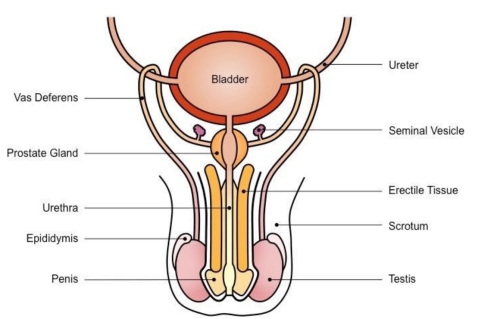Lesson Notes By Weeks and Term - Senior Secondary School 2
MALE AND FEMALE REPRODUCTIVE STRUCTURES
SUBJECT: BIOLOGY
CLASS: SS2
DATE:
TERM: 3RD TERM
REFERENCES
WEEK THREE
MALE AND FEMALE REPRODUCTIVE STRUCTURES
CONTENT
REPRODUCTIVE SYSTEM
Most multicellular animals and plants undergo a complex form of sexual reproduction in which especially differentiated male and female reproductive cells (gametes) unite to form a single cell, known as a zygote, which later undergoes successive divisions to form a new organism. The process takes place with the help of the system known as the reproductive system. This system can be divided into
STRUCURES AND FUNCIONS OF MALE REPODUCION SYSTEM IN MAMMALS

STRUCTURE | DESCRIPTION | FUNCTIONS |
Testis | Oval shaped, found in scrotal sacs in pairs outside the body to enjoy cooler temperature. |
. |
Seminiferous tubules | Found within the testis, composed of a mass of sperm producing tubes. | Site of sperm production |
Epididymis | Found outside the testis as a long coiled tube. | Collect and stores sperm temporary till maturity. |
Vas deferens (sperm duct) | A narrow tube which leads from epididymis to the seminal vesicles. | Conduction of sperm from epididymis to seminal vesicle. |
Seminal vesicle | A small sac at the back of vas deferens. |
NOTE; Seminal fluid contains fructose which provides energy for the sperms. |
Prostrate gland | Connected to the urethra through many tubules | Secretion of seminal fluid. |
Cowper’s gland | Located very close to the prostrate gland. | Secretes a part of the seminal fluid which raises the acidic ph of the female reproductive medium which otherwise can kill the sperm. |
Urethra | A narrow tube which passes through the penis. | Aids the passage of sperm into the vagina of the female animal and also passage of urine out of the body hence it is called urinogenital opening. |
Penis | Contains tissues which makes it turgid (erect when filled) with blood | Helps to introduce sperm into the vagina of the female animal and also passage of urine. |
EVALUATION
STRUCTURES AND FUNCTIONS OF THE FEMALE REPRODUCTIVE SYSTEM

STRUCTURE | DESCRIPTION | FUNCTION(S) | |
1 | Ovaries | Found on each side of the vertebra column (two in every woman) | - Produce eggs (ova) - produces female sex hormone (oestrogen and progesterone) - Development of secondary sexual characters in female. |
2 | Oviduct (fallopian tube) | A long narrow tube funnel opening which receives eggs released by the ovary and it is a linkage between ovary and uterus. | -Fertilization takes place in the oviduct - Allows the passage of egg from ovary to the uterus |
3. | Uterus | A muscular organ which is a cavity for development of the zygote into a baby. | - Site of embryo development from implantation till birth |
4. | Vagina | A muscular tube leading from the uterus to the outside of the body. | - It receives sperms from penis during intercourse -Allows the passage of foetus during birth |
5 | Cervix | A ring of muscles with tiny opening that closes the lower end of the uterus where it joins the vagina. | -Controls the opening and closing of the vagina especially during birth. |
6 | Vulva | Refers to all external parts of the female reproductive organ | - Allows the passage of the penis into the vagina during intercourse. - permits passage of foetus during birth. |
7 | Clitoris | A small sensitive organ which correspond to the male penis. It is erectile and becomes stiff when stimulated due to blood inflow |
|
EVALUATION
STRUCTURE OF MAMMALIAN GAMETES
GAMETE
Gamete is a mature sexual reproductive cell having a single set of unpaired chromosome. It can be male or female gamete. They are formed in the gonads (testis on ovaries) through a process called gametogenesis.
MALE GAMETE

A SPERM
This is called sperm (or spermatozoa) and produced in the male gonads (testis) by a process called spermatogenesis. It is microscopic and unicellular in nature. Usually smaller and more elongated than the egg; about 0.05 mm (0.005 cm) long.
Spermatozoon consists of the following parts:
fertilization.
FEMALE GAMETE
THE OVUM
This is called egg (ovum) and is produced in the female gonad (ovary) by a process called oogenesis. This is larger than sperm, about 0.1mm in diameter.
Each ovum is made up of the following
Note: The nuclei of the sperm and ovum contains chromosome which carries the gene that are responsible for transmission of characters from parents to offspring.
GENERAL EVALUATION
READNG ASSIGNMENT
College Biology, chapter 16, pages 292-324
WEEKEND ASSIGNMENT
SECTION A
SECTION B
© Lesson Notes All Rights Reserved 2023